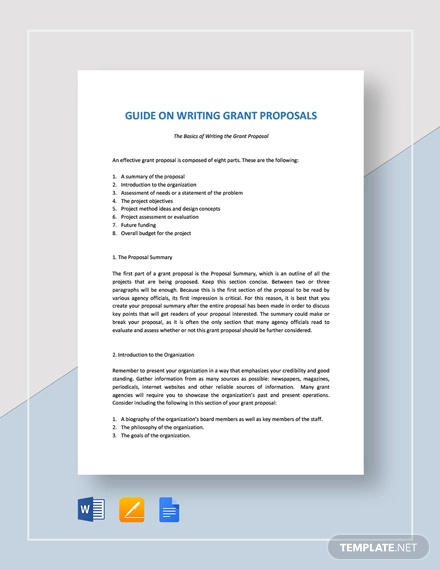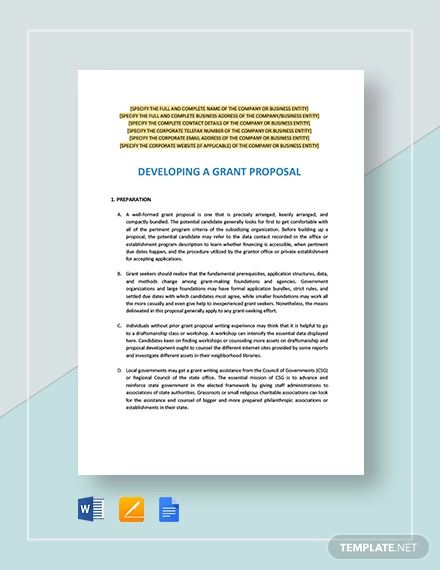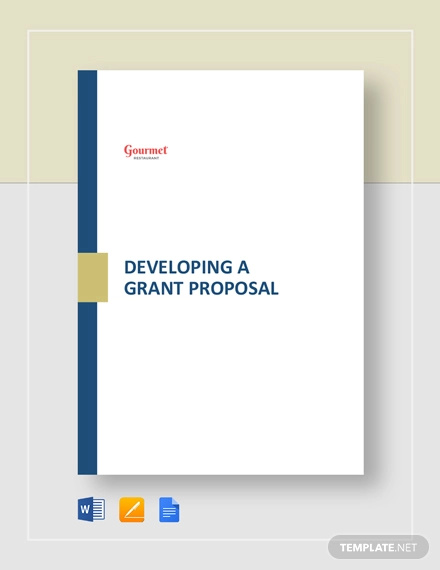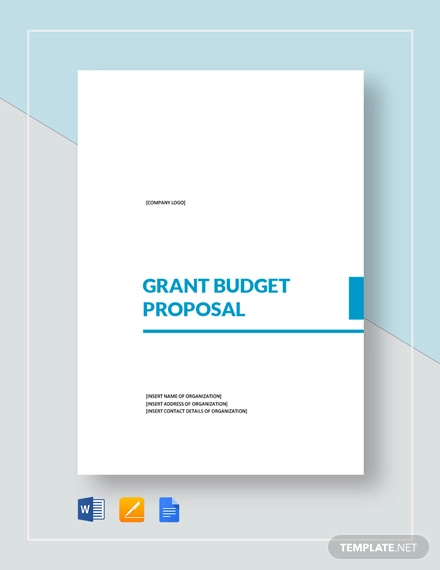Writing a Grant Proposal Examples to Download to Download
Although most nonprofits would consider a grant proposal as a request for money, this belief is only partially correct. Grant proposals are created to help an organization obtain the best results for their constituents and move at a better pace toward their primary mission. This is why it’s important for a nonprofit to consider these grants from a mission-focused perspective.
But grant proposal writing isn’t as easy as it seems. You’ll want to make sure that you develop a specific and meaningful action plan that tackles what you want to do and why you want to do it. You’ll need to consider how your plan can achieve positive results, as well as the other components that make up a persuasive grant proposal. So in this article, let’s discuss the basics of grant proposal writing for you to be guided.
Writing the Grant Proposal Template

Developing a Grant Proposal Template

Restaurant Developing a Grant Proposal Example

Grant Budget Proposal Template

Guidelines for Writing a Grant Proposal
A grant proposal is a clear and direct formal document addressed to a particular organization or funding agency with the main purpose of persuading an audience to provide you with support for a valuable cause.
Many nonprofits or non-government organizations need these general proposals to secure funds and other means of support from a corporate firm or sponsor. For this reason, the document must be made specific and credible enough for readers to fully understand where you’re coming from with your proposal.
As you begin planning and drafting your grant proposal, ask yourself the following questions:
1. Who is your audience?
Think about all the people who will read this proposal. One of your main goals as a proponent is to give your audience a reason to be interested in what you’re proposing. To do so, you must gain a proper understanding of the agency’s personal mission, professional goals, and values.
Seeing your audience from a more practical perspective offers you a meaningful insight as to how you could present your general plan, what language or vocabulary to use, how much background or history to provide, and the kind of information that readers will consider to be the most persuasive.
Keep in mind that readers may look for different things in your simple proposal, depending on what they find to be the most valuable. Some readers see value in numbers and quantitative data, while others might want testimonials, recommendations, or a historical precedent instead. It’s best to conduct your own research on the matter for a more trusted approach.
2. What are the expectations for this grant?
In most cases, there are standards set by the granting organization that proponents must adhere to. You can make an inquiry regarding such before you begin writing the proposal to avoid wasting any time and energy on something that’s likely to be ignored. Pay attention to these requirements and make sure to produce a document that is nothing short than what is expected from you.
For your own benefit, try studying representative samples of successful proposals in the field you are in or those proposals that have received the same type of grant you are applying for. This way, you’ll know exactly how to please your audience with a well-written proposal. You may also see business proposal examples.
3. How do you establish credibility?
You need to present yourself as a capable and knowledgeable proponent from the eyes of your readers. After all, the worst thing that could happen is for a grant to be offered to an undeserving (or perhaps even an unreliable) organization. You may also like service proposal examples.
You can establish your credibility through the thoroughness of your proposed plan. The knowledge you possess about a particular matter and the way you present its importance and value for a cause can say a lot about how sincere you are with your plan. You may also check out research proposal examples.
You can also provide any references that point to your past accomplishments in order for you to verify your ability to succeed, along with your undying commitment to the proposed project. Partnerships or collaborations with complementary individuals and organizations may be outlined in the proposal as well.
4. How do you present your plan?
It’s a good idea to observe a proper format and structure for your professional proposal. This will help present your plan in a clear and logical manner for readers to grasp. You can do so by dividing your proposal into different sections and then labeling them according to their specified roles in the document. There may also be heading and content requirements established by the granting agency for proponents to abide to.
Some grant writers also suggest using numbered lists or bullet lists to organize their ideas accordingly. While these lists may not seem eloquent for some, it’s still an efficient way to present important information in a quick yet clear manner. You may also see short proposal examples.
Additionally, be sure to keep your simple grant proposal direct and to the point. There’s no room for flowery metaphors and literary allusions in something as formal as a grant proposal, so cut to the chase, and focus on using an uncluttered and concise language. You must communicate in such a way that is clear and detailed enough for readers to fully understand your message.
Using a vivid image, a compelling anecdote, or a memorable phrase to help create urgency and importance to what you are proposing to do if you were offered the grant will increase your chances of being approved.
Common Elements of a Grant Proposal

Every proposal, whether it’s a business proposal or a thesis proposal, is broken down and organized into different sections to emphasize each aspect of the document. Though these sections may have different titles depending on what has been specified by the granting agency, they usually serve the same purposes.
Here are some of the most common elements found in a grant proposal:
1. Short overview
This section also functions as an executive summary or abstract of the proposal. Here, you must present the main points of your proposal in as few sentences as possible. Some proponents like to condense this section into one complete paragraph, but a page-full overview would still be accepted, especially for longer proposals.
Either way, the overview must indicate the principal goal of the project, the problem or need for it, the expected outcomes and your means for achieving it, how the success of the project would be measured, and briefly, who you are as a proponent. You may also see request for proposal examples.
2. Examination of the need or problem
The general statement of the problem should explain the need for such project. Grants are typically used to respond to a gap in resources, knowledge, or opportunity that really needs to be filled. It’s important to clarify this need or problem for you to effectively establish the value of your project. You can also provide supporting data and a short literature review to verify its significance in the field.
3. Project description
This is the part where you’re tasked to describe your project for readers to comprehend. State your project goals, your project’s outcomes, how you plan to achieve these outcomes, how you will recognize your project’s achievements, and the timeline for your project. You may also like security proposal examples.
Donors or sponsors would want to make sure that you’ve clearly established the realistic benefits of your work, so you need to make this apparent in your project description.
4. Budget
It’s important to clarify what you’re asking for, as well as your reason for asking such amount. Budgets are often presented through tables and figures for better comprehension. A breakdown of your proposed budget should justify why each cost, material, and equipment is essential to a project’s development. You may also check out partnership proposal examples.
5. Other possible sections required
Though this may not be applicable all the time, some granting agencies may request for a cover letter, organizational qualifications, and other supporting documents from proponents. The appendices section of your basic proposal may consist of additional records such as tax status information, endorsements, survey forms, illustrations, and other types of documentation that are directly related to your proposal.
Writing a grant proposal can be a long, daunting task to accomplish. It demands a proponent’s close analysis on a vision and a critical consideration on how your solution may respond to a gap, problem, or deficiency.
Even then, there’s no assurance that the process would end as successfully as you hoped it would. One of the best ways to write a credible and persuasive grant proposal is to analyze sample proposals that have been submitted in the past. Through these samples and the guidelines listed above, you can craft the perfect grant proposal to increase your chances of being approved. You might be interested in commercial proposal examples.


